US5830277
1. A thermal processing system for processing a semiconductor substrate at a processing temperature comprising:
a processing chamber within which the substrate is placed for processing;
at least one heater for providing heat to the processing chamber;
a shield comprising a material substantially nontransmissive to light within a given range of wavelengths at the processing temperature;
the shield forming a cavity adjacent to the substrate wherein extrinsic light within the given range of wavelengths is prevented from reflecting into the cavity;
the shield absorbing heat and emitting substantial thermal radiation within the cavity;
wherein the shield provides thermal insulation for maintaining substantial temperature uniformity of the substrate during processing; and
a first optical sensor disposed for sampling the intensity of light in the cavity within the given range of wavelengths and for producing an output representative of said intensity.
US5538825
1. A process which comprises (a) providing a migration imaging member which comprises a substrate and a softenable layer comprising a softenable material and a photosensitive migration marking material; (b) providing a printing plate precursor which comprises a base layer and a layer of photosensitive material selected from the group consisting of photohardenable materials and photosoftenable materials; (c) placing the softenable layer of the migration imaging member in contact with the layer of photosensitive material of the printing plate precursor and applying heat and pressure to the migration imaging member and printing plate precursor, thereby causing the softenable layer of the migration imaging member to adhere to the layer of photosensitive material of the printing plate precursor; (d) uniformly charging the migration imaging member; (e) subsequent to step (d), exposing the charged imaging member to activating radiation at a wavelength to which the migration marking material is sensitive; (f) subsequent to step (e), causing the softenable material to soften and enabling the migration marking material to migrate through the softenable material in an imagewise pattern, thereby resulting in the layer of softenable material becoming transmissive to light in areas where the migration marking material has migrated and remaining nontransmissive to light in areas where the migration marking material has not migrated; (g) subsequent to step (f), uniformly exposing the migration imaging member and the printing plate precursor to radiation at a wavelength to which the photosensitive material on the printing plate precursor is sensitive, thereby causing the photosensitive material on the printing plate precursor to harden or soften in areas situated contiguous with light-transmissive areas of the softenable layer, thereby forming an imaged printing plate; and (h) subsequent to step (g), removing the migration imaging member from the imaged printing plate.
WO2019140413
[0201] The additional CES materials that do not transmit light are added to the mixture(s) to absorb random stray light, similar to EM A in traditional optical fiber technologies,
【0134】
光を透過しない追加のCES材料が、混合物(複数可)に添加されて、従来の光ファイバ技術におけるEMAに類似するランダムな迷光を吸収するが、
except that the distribution of the absorbing materials may be random in all three dimensions, as opposed to being invariant in the longitudinal dimension.
吸収材料の分布は、長手方向寸法が不変であることとは対照的に、3つすべての次元においてランダムであり得る。
US10189237
[0002] A 3D printing process may use a feedstock material, extruded from a print head, to additively manufacture a part by layering the feedstock material.
【0002】
3D印刷プロセスは、例えば、プリントヘッドから押し出されるフィードストック材料を用い、このフィードストック材料を積層して部品を付加製造するプロセスである。
The feedstock material may comprise a polymer and reinforcing fibers, such as carbon fibers, which are opaque to visible and ultra-violet light.
フィードストック材料は、ポリマーと、可視光及び紫外光を透過しない、炭素繊維などの強化繊維と、を含んでなる。
EP2831815
The articles do not generally transmit significant amounts of light from the front side to the rear side, or vice versa,
物品は、通常、表側から裏側へ及び裏側から表側へは有意な量の光を透過しないが、
due at least in part to the presence of a substance or layer on the retroreflector such as a vapor coat of metal, a seal film, and/or an adhesion layer.
これは、少なくとも部分的に、金属蒸着コート、シールフィルム、及び/又は接着層のような、再帰反射材上の物質又は層の存在による。
WO2017194502
Fig. 2b schematically depicts in top view part of the plant 100, in top view, with the mask over the plant part 110.
【0074】
図2bは、植物部分110上にマスクがある、植物100の一部を上面図で概略的に示す。
The mask comprises a second mask part 162 that is transmissive for light - here a V-sign - and a third mask part 163 that is less light transmissive to light than the second mask part 162 or is not light transmissive,
マスクは、光を透過する第2のマスク部分162(ここではV記号)と、第2のマスク部162よりも光を透過しない、又は光を透過しない第3のマスク部分163とを含み、
with the second mask part 162 (substantially) consequently corresponding to the second plant part 120 and the third mask part 163 (substantially) consequently corresponding to the third plant part 130.
第2のマスク部分162は(実質的に)結果的に第2の植物部分120に対応し、第3のマスク部分163は(実質的に)結果的に第3の植物部分130に対応する。
WO2017172689
In contrast, portions of the rear panel-facing surface 203 in second regions 212, which do not comprise an activated component in contact therewith,
対照的に、第二領域112における当該リアパネルに面した表面103の一部は、それと接触するアクティブ化された構成要素を含まず、
will not exhibit reduced TIR (e.g., TIR > 90%)
よって、減少したTIRを示さず(例えば、TIR>90%)、
and the corresponding regions of the light-emitting surface 202 will not, or will not substantially, transmit light.
当該光放出面102の当該対応する領域は、光を透過しないか、または実質的に透過しないであろう。
Accordingly, in some embodiments, when viewed by a user, a portion of a display corresponding to first region(s) 211' may appear illuminated whereas a portion of the display corresponding to the second region(s) 212 may appear dark.
したがって、いくつかの実施形態において、使用者によって見られるとき、第一領域111’に対応するディスプレイの一部は、照明されているように見え得るが、その一方で、第二領域112に対応するディプレイの一部は、暗く見え得る。


























※コメント投稿者のブログIDはブログ作成者のみに通知されます